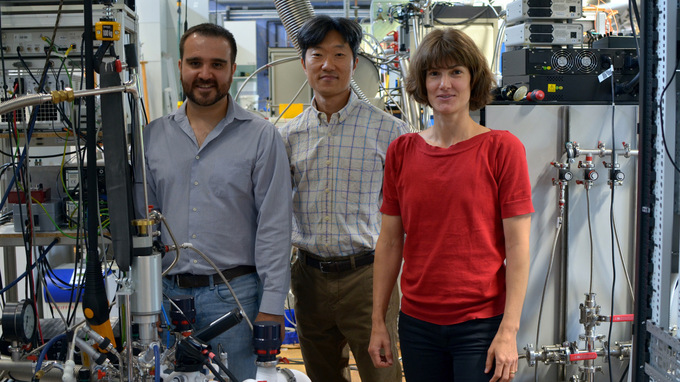Unusual superconductivity with two phases
New heavy fermion superconductor shows surprising characteristics
2021-08-29 – News from the Physics Department

Symmetry and symmetry breaking are key for the understanding of many interesting phenomena in condensed matter physics. Conventional superconductivity, i.e. superconductivity caused by phonon-electron coupling, for example, requires both time reversal and inversion symmetry, and removing one of them - like time reversal by a magnetic field - leads to the suppression of the superconducting order.
Since 2004, non-centrosymmetric superconductors became of interest whereby the lack of inversion symmetry is leading to spin-singlet and spin-triplet Cooper pair mixing in the superconducting phase. In fact, these superconductors are very robust against the application of a magnetic field due to strong spin-orbit coupling effects that arise because of the broken inversion symmetry.
Phase transition at 4 T
Scientists from the Max Planck Institute for Chemical Physics of Solids, the Technical University of Munich and international research institutions are now reporting on the measurement of a two-phase unconventional superconductivity in CeRh\(_2\)As\(_2\), a new heavy fermion superconductor. In the superconducting state, the researchers measured an internal phase transition at around 4 T when the magnetic field is applied in the direction of the crystallographic c axis. Such a phase transition at ambient pressure has so far been observed very rarely and is only known from UPt\(_3\). This exotic superconductor shows three superconducting phases at different temperatures and magnetic fields, but their nature is unclear.
‘We suggest that these observations in CeRh\(_2\)As\(_2\) result from physics different from that at play in UPt\(_3\),’ says Elena Hassinger, Professor for experimental solid-state Physics at TUM and research group leader at the Max Planck Institute for Chemical Physics of Solids in Dresden. “The key superconducting properties of CeRh\(_2\)As\(_2\) are likely a manifestation of the local inversion symmetry breaking and consequent Rashba spin-orbit coupling in an overall inversion-symmetric crystal structure.”
Manifestation of a local symmetry breaking
Although CeRh\(_2\)As\(_2\) is centrosymmetric with inversion symmetry, the material is locally non-centrosymmetry, with an inversion symmetry linking two non-centrosymmetric Ce-square lattices, each of which has a Rashba interaction. “You could think of it as a double-layer system with an interplay between an intralayer Rashba interaction and interlayer hopping, which leads to a c axis field-driven transition between two superconducting phases. In the low-field state, the superconductivity is of even parity, i.e. the sign of the wave function is the same on these two Ce layers, whereas the high-field state is of odd parity with alternating sign on the Ce layers.”
The unusual directional dependence of the critical magnetic field in CeRh\(_2\)As\(_2\) also fits into this picture: In the direction of the crystallographic c axis, the material shows an extremely high critical field (14 T) at a transition temperature of only 0.26 K, far larger than in the ground plane (1.9 T).
“Our observations that likely result from the local surrounding of Ce suggest that CeRh\(_2\)As\(_2\) will be a benchmark material to study the influence of spin-orbit coupling on electronic mechanisms for unconventional superconductors”, says Elena Hassinger.
- Editing
- Petra Riedel
Publication
Further information
Scientists from the following institutions were involved in the study: Max Planck Institute for Chemical Physics of Solids, Dresden; University of Otago, New Zealand; University of St. Andrews, Great Britain; University of Wisconsin-Milwaukee and Technical University of Munich. In Germany, the research was supported by the Max Planck Society and the Deutsche Forschungsgemeinschaft (DFG).